Glenn Ligon facts for kids
Quick facts for kids
Glenn Ligon
|
|
|---|---|
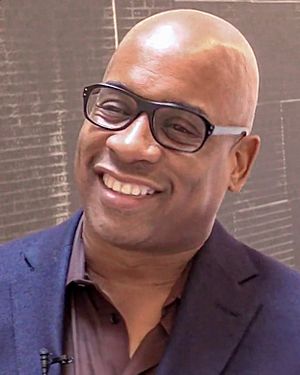
Ligon in 2014
|
|
| Born | 1960 (age 65–66) The Bronx, New York City, U.S.
|
| Education | Wesleyan University |
| Known for | Conceptual art |
Glenn Ligon (born 1960, pronounced Lie-gōne) is an American conceptual artist. His art explores important ideas about race, language, and what makes us who we are. Ligon lives in New York City. His work often uses words and ideas from famous writers and speakers from the 1900s. These include people like James Baldwin and Zora Neale Hurston. He is also known for helping to create the idea of "Post-Blackness" in art.
Contents
Early Life and Art Career
Glenn Ligon was born in 1960 in the Bronx, New York. When he was seven, he and his older brother received scholarships. This allowed them to attend Walden School, a good private school in Manhattan.
Ligon first studied at the Rhode Island School of Design. After two years, he moved to Wesleyan University. He earned his degree in 1982. After college, he worked as a proofreader for a law firm. In his free time, he painted in a style called Abstract Expressionism.
In 1985, he joined a special study program at the Whitney Museum of American Art. He still lives and works in New York City.
Ligon started as an abstract painter. But in the mid-1980s, he began to add words and text to his art. He wanted to better share his thoughts on social issues and racial identity. Much of the text he used came from important African-American writers.
Ligon became well-known in the early 1990s. He was part of a group of new artists.
About Glenn Ligon's Life
Ligon lives in Tribeca, a neighborhood in New York City. He has been on the board of directors for several art foundations. These include the Foundation for Contemporary Arts and the Robert Rauschenberg Foundation. His art studio in Brooklyn is close to where his artist friends Paul Ramirez Jonas and Byron Kim also work.
Glenn Ligon's Artworks
Ligon creates art using many different materials. These include paintings, neon lights, videos, and photographs. His art is deeply shaped by his experiences as an African American man in the United States.
Artworks Using Text
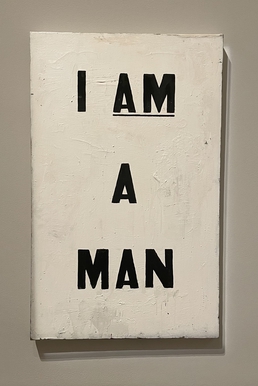
Even though Ligon makes sculptures, prints, and neon art, painting is still very important to him. He adds text to his paintings. He uses parts of books, jokes, or quotes from different authors. He stencils these words onto the canvas by hand. His ideas often come from the history and experiences of Black Americans.
In 1990, he had his first solo art show called "How It Feels to Be Colored Me." This show made him famous for his large, text-based paintings. In these works, a phrase from a book or other source is repeated over and over. As he layers the stenciled text, it can become smudged and hard to read.
Untitled (I Am a Man) (1988) is an early example of his text art. It reworks the signs carried during the Memphis sanitation strike in 1968. These signs became famous from Ernest Withers's photographs. In other paintings, Ligon repeats text until it's almost impossible to read. This makes viewers look closely to try and understand the hidden words. For example, in Prologue Series #2 (1991), he stenciled the beginning of Ralph Ellison's Invisible Man. The words become less clear as they go down the painting.
In 1993, Ligon started a series of paintings based on Richard Pryor's comedy routines from the 1970s.
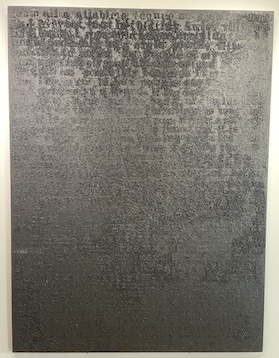
In his Stranger series, Ligon explores ideas from James Baldwin's 1953 essay, "Stranger in the Village." This series began in 1996. He used parts of the essay, stenciling them so they became harder to read. In 2021, Ligon showed the full essay in large text paintings.
Glenn Ligon's Debris Field series started with etchings in 2012. In 2018, he made paintings in this series. These paintings also use stencils, but they don't use existing texts. Instead, the Debris Field series uses stencils of letters that Ligon created himself. The letters are placed all over the canvas. Even though they are letters, they stack and layer. This continues Ligon's interest in how clear words are and the mix of clear shapes and abstract art.
To Disembark (1993) and Runaways (1993)
In 1993, Ligon's exhibition To Disembark was shown at the Hirshhorn Museum and Sculpture Garden. The title comes from a poetry book by Gwendolyn Brooks. This show connected the history of American slavery to unfairness today. It showed how African Americans still deal with the effects of slavery and racism.
In the main artwork of the show, Untitled (To Disembark) (1993), Ligon made packing crates. These crates were like the one described by Henry "Box" Brown. Brown was an enslaved person who escaped by mailing himself in a box from Virginia to freedom in Philadelphia. Ligon built nine crates for the exhibition and placed them around the gallery.
Ligon also learned that Brown was singing when he arrived in Philadelphia. To include this, Ligon put speakers inside the crates. They quietly played songs like "Strange Fruit" by Billie Holiday and "Sound of da Police" by KRS-one. Each crate played a different sound, like a heartbeat or a spiritual song. The mix of these songs from different times showed the lasting effects of slavery.
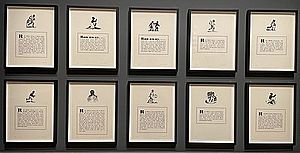
The exhibition also included Runaways (1993). This is a set of 10 prints. Ligon asked friends to describe him. He then used these descriptions as text on posters. The posters looked like the old "runaway slave" ads from the 1800s.
In another part of the exhibition, Ligon stenciled four quotes from a 1928 essay by Zora Neale Hurston. The essay was called "How It Feels To Be Colored Me." Ligon found Hurston's writing helpful because it explored the idea that race is shaped by situations, not just by who someone is.
Notes on the Margin of the Black Book (1991-1993)
In Notes on the Margin of the Black Book (1991-1993), Ligon responded to Robert Mapplethorpe's photographs. Ligon cut pages from a book of Mapplethorpe's photos. He framed 91 of these pictures and put them in two rows. Between them, he placed two more rows of small framed texts. These texts were 78 comments about art and the discussions around Mapplethorpe's work. Ligon showed these pictures in a museum. This allowed people to openly discuss the images and the ideas around them.
Feast of Scraps (1994-98)
In A Feast of Scraps (1994–98), Ligon added images of Black men from certain magazines. He gave them made-up captions like "mother knew" or "It's a process." He put these into albums of family photos. These albums included pictures of graduations, vacations, baby showers, and birthdays. Some photos were of Ligon's own family. This project explores hidden stories and meanings in old texts and images.
Coloring Book Series
Another series of large paintings is based on children's coloring books from the 1970s. These books featured drawings of important Black history figures. This series began when Ligon was an artist at the Walker Art Center in 1999-2000. There, he worked with schoolchildren. They colored pages from old coloring books. Ligon then made paintings and drawings using silkscreen and paint on canvas and paper. These works showed the children's coloring. Figures like Malcolm X, Harriet Tubman, and Isaac Hayes appear in these artworks.
Neon Artworks

Since 2005, Ligon has created art using neon lights. Warm Broad Glow (2005) was his first neon piece. It uses words from Three Lives, a 1909 novel by Gertrude Stein. Ligon made the words "negro sunshine" in warm white neon. He then painted the front of the letters black. This piece was shown at the Whitney Museum in 2011. Other neon works are inspired by neon sculptures by Bruce Nauman. For example, One Live and Die (2006) comes from Nauman's 100 Live and Die (1984).
Ligon's large artwork A Small Band (2015) has three neon pieces. They light up the words "blues," "blood," and "bruise." This work was first made for the Venice Biennale, a big art show. It has since been shown in different places like the Stony Island Arts Bank in Chicago. The three words in A Small Band refer to a 1966 sound piece by composer Steve Reich.
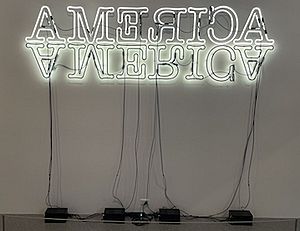
Ligon has created other large neon artworks. Des Parisiens Noirs (2019) shows the names of 13 Black models from famous historical paintings. It was shown inside the Musée d'Orsay in Paris. This project was part of an exhibition called "Black Models: From Géricault to Matisse." This show focused on models of African descent in historical paintings. One of the 13 neon signs says "nom inconnu" (name unknown). This acknowledges models whose names are not known.
In 2021, Ligon created Waiting for the Barbarians for an exhibition in Athens, Greece. This artwork uses the last two lines of a 1904 poem by C. P. Cavafy. These lines are: "Now what's going to happen to us without barbarians? Those people were a kind of solution." His neon artwork shows nine different English translations of these lines. This highlights how different translations can change the meaning. It also explores how some groups of people are seen as "others."
The Death of Tom (2008)
In 2008, Ligon made a short film called The Death of Tom. It is based on Thomas Edison's 1903 silent film Uncle Tom's Cabin. Ligon played the character of Tom. He filmed himself re-creating the last scene of Edison's movie. However, the film was loaded incorrectly in the camera. So, no images appeared on the film. Ligon decided to show his film as an abstract mix of light and shadow. A jazz musician named Jason Moran created music for it.
Art Exhibitions
In 2011, the Whitney Museum of American Art held a large exhibition of Ligon's work. It was called Glenn Ligon: America. This show also traveled to the Los Angeles County Museum of Art.
Other important recent shows include:
- Grief and Grievance (2021) at the New Museum, where Ligon helped plan the show.
- Des Parisiens Noirs at the Musée d'Orsay, Paris (2019).
- Blue Black (2017), an exhibition Ligon organized at the Pulitzer Arts Foundation.
- Glenn Ligon: Encounters and Collisions (2015), a project with Nottingham Contemporary and Tate Liverpool.
Ligon has also had solo exhibitions at other museums. His work has been shown in major international art events. These include the Venice Biennale (2015 and 1997) and Documenta XI (2002).
Famous Artworks in Public Collections
- Untitled (I Am a Man) (1988), National Gallery of Art, Washington, D.C.
- Backlash, Backlash... (1991), Art Institute of Chicago
- I Feel Most Colored (1992), Blanton Museum of Art, Austin, Texas
- Untitled (1992), Baltimore Museum of Art
- Untitled series (1992), Minneapolis Institute of Art
- Untitled (Black Like Me #2) (1992), Hirshhorn Museum and Sculpture Garden, Smithsonian Institution, Washington, D.C.
- Untitled (I'm Turning Into a Specter before Your Very Eyes and I'm Going to Haunt You) (1992), Philadelphia Museum of Art
- Notes on the Margin of the Black Book (1991–93), Solomon R. Guggenheim Museum, New York
- Black & White (1993), by Glenn Ligon and Byron Kim, Smithsonian American Art Museum, Smithsonian Institution, Washington, D.C.
- Runaways series (1993), Addison Gallery of American Art, Andover, Massachusetts; Amon Carter Museum of American Art, Fort Worth, Texas; Birmingham Museum of Art, Alabama; The Broad, Los Angeles; Harvard Art Museums, Cambridge, Massachusetts; Metropolitan Museum of Art, New York; Mildred Lane Kemper Art Museum, St. Louis; Museum of Contemporary Art, Chicago; Museum of Modern Art, New York; National Gallery of Art, Washington, D.C.; Rhode Island School of Design Museum, Providence; St. Louis Art Museum; Tang Teaching Museum and Art Gallery, Saratoga Springs, New York; and Whitney Museum, New York
- White #15 (1994), Wadsworth Atheneum, Hartford, Connecticut
- Condition Report (2000), Tate, London
- Malcolm X, Sun, Frederick Douglass, Boy with Bubbles (version 2) #1 (2000), Walker Art Center, Minneapolis
- Self-Portrait at Eleven Years Old (2004), Museum of Modern Art, New York
- Untitled (If I Can't Have Love I'll Take Sunshine) (2006), Warwick Arts Centre, Coventry
- Rückenfigur (2009), Los Angeles County Museum of Art and Whitney Museum, New York
- Warm Broad Glow II (2011), Glenstone, Potomac, Maryland and Whitney Museum, New York
- Double America (2012), National Gallery of Art, Washington, D.C.
- Stranger #56 (2012), Musée National d'Art Moderne, Centre Pompidou, Paris
- Live (2014), Crystal Bridges Museum of American Art, Bentonville, Arkansas, and National Portrait Gallery, Smithsonian Institution, Washington, D.C. (jointly owned); and San Francisco Museum of Modern Art
In 2012, Ligon was asked to create the first special artwork for the New School's University Center building in New York City. The artwork, For Comrades and Lovers (2015), uses about 400 feet of text from Walt Whitman's Leaves of Grass. It is made of violet neon light and runs around the top of a wall in the building's café.
Awards and Recognition
Glenn Ligon has received many awards for his art:
- In 2003, he won a John Simon Guggenheim Memorial Foundation Fellowship.
- In 2005, he received an Alphonse Fletcher Foundation Fellowship.
- In 2006, he was given the Skowhegan Medal for Painting.
- In 2009, he received the Studio Museum's Joyce Alexander Wein Artist Prize.
- In 2010, he won a United States Artists Fellow award.
In 2009, President Barack Obama added Ligon's 1992 painting Black Like Me No. 2 to the White House collection. It was placed in the President's private living area. The text in this painting comes from John Howard Griffin's 1961 book Black Like Me. The words "All traces of the Griffin I had been were wiped from existence" are repeated. They overlap until they become a field of black paint.
In 2018, Ligon received an Honorary Doctorate from The New School. In 2021, he was chosen as a member of the American Academy of Arts and Letters.
See also
- African-American art
- African-American literature
- Conceptual art
- Glenn Ligon at the Minneapolis Institute of Art , Minneapolis, MN

